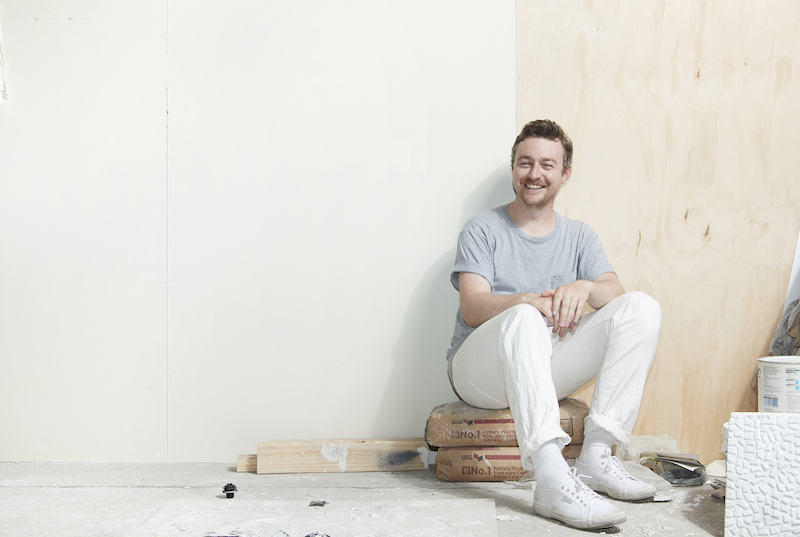Cool Hunter Predictions: Adam John Cullen
Neither sculptor, nor ceramicist, nor painter, Adam John Cullen is difficult to pin down under any definitive category of contemporary art.
Words: Paris Lettau
Photography: Zan Wimberely
In Melissa Loughnan’s recent survey of Australia’s leading artists, Australiana to Zeitgeist: an A-Z of Contemporary Australian Art (Thames and Hudson Australia, 2017), Adam John Cullen appears alongside two other artists under the books final thematic: ‘zeitgeist’. The term zeitgeist, which refers to the spirit or mood of the times, is both apt and inapt to describe Cullen’s practice. Apt because Cullen has been presented at the forefront of contemporary art’s recent turn to sculpture and ceramics (an association he actually distances himself from, despite being shortlisted for the Shepparton Art Museum, Sidney Myer Australian Ceramic Award in 2015). Inapt because Cullen’s practice in fact problematises the very concept of a zeitgeist, as a unified cultural mood, that Loughnan tries to pin him under.
Aspects of personal memory, culture, history, and economic and political relations surface in Cullen’s work through the various personal objects and ephemera that he has accumulated across the years and that constantly appear and re-appear throughout his various works. This includes chains, candle holders, souvenirs, neck- laces, t-shirts such as Cullen’s old battered one bearing the words ‘WHERE THE HELL IS COOTAMUNDRA’ (Cullen’s hometown), or a Rosetta Stone bag he purchased from the British Museum, London. Even plastics, stone and, in Forever Stuff (2014) presented at Shepparton Art Museum, the geological origins and international trade of a ‘fleck of sand from a distant coastline’ (part of the plaster Cullen uses) forms the archaeological backdrop to a series of works, each baring traces of personal and social significance.
Cullen’s practice has grown out of the circuit of artist run and public galleries that support Melbourne’s established artists and rising stars. He has had an important presence at TCB Art Inc in central Melbourne, having a joint exhibition in 2011 and solo one in 2014. He also holds a studio with a number of Melbourne’s leading artists at Gertrude Contemporary’s new Preston gallery (Melbourne’s centre-stage and launching pad for up-and-coming artists). This year he presented Dissolve (2017) at Gertrude Contemporary Glasshouse, Collingwood, exhibiting an installation of various plaster forms, each moulded and filled with his personal objects.
It’s not just Melbourne, though; Cullen has also developed a growing presence in Sydney, in particular at Alaska Projects, where he has presented solo shows over the past two years, including Burnout (2015) and Bapaume Street (2016). He is currently planning to exhibit again at Alaska Projects in 2018.
A recent highlight for Cullen was his inclusion in Primavera 2017: Young Australian Artists (23 August – 19 November 2017) at the Museum of Contemporary Art, Sydney. In Certain Remnants (2017), seven ostensible works or manifestations appear: plinth like constructs chipped away at by Cullen like archaeological ruins, and small piles of what appear to be discarded remanets. Here, Cullen follows an artistic process repeated throughout most of his works. He first creates casts (of vases, plinths, columns etc.) in which his objects and mementos are then mixed, coloured, broken-up, dissolved or poured into (and then filled in with plaster) to form a cast of the original form, now buried with personal objects and memories. After, the cast forms are then either broken apart or chipped away at like an archaeologist searching for lost memories.
These objects and mementoes form into ‘finished’ works, however in time they will once again be removed, broken up, brought back to dust by Cullen and, like Phoenixes rising from the ashes, re-used in later projects and sculptures. Cullen’s practice continues in this way, in constant reformation, recycling, reconstruction and deconstruction; each exhibit is really just a petrified moment of a practice in a constant state of becoming.
Neither sculptor, nor ceramicist, nor painter, Cullen is difficult to pin down under any definitive category of contemporary art. It is this quality—of somehow not quite belonging to our times—that shows Cullen’s practice has something to offer us, and perhaps explains his growing presence in Australian contemporary art.
This article was originally published in Art Collector issue 83, JAN – MAR, 2018.









